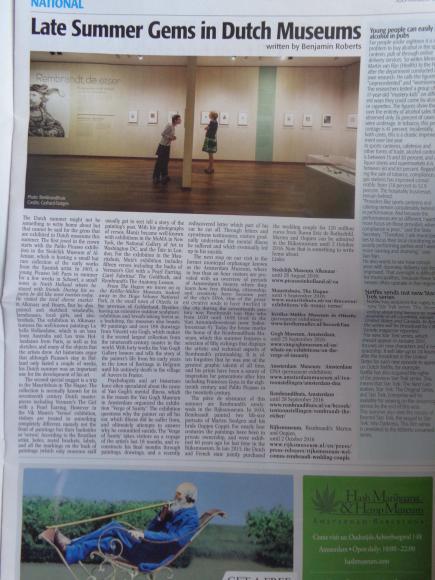- Nederlands
- English
Summer 2016: ARTS & CULTURE: Late Summer Gems in Dutch Museum

The Dutch summer might not be something to write home about but that cannot be said for the gems that are exhibited in Dutch museums this summer. The first jewel in the crown starts with the Pablo Picasso exhibition in the Stedelijk Museum of Alkmaar, which is hosting a small but rare collection of the early works from the Spanish artist. In 1905, a young Picasso left Paris to summer for a few weeks in Schoorl, a small town in North Holland where he stayed with friends. During his sojourn, he did like most tourists today. He visited the local cheese market in Alkmaar and Hoorn. But he also painted and sketched windmills, farmhouses, local girls, and also brothels. The exhibition in Alkmaar features the well-known paintings La belle Hollandaise, which is on loan from Australia and Les trois Hollandaises from Paris, as well as his sketches, and many of the objects that the artists drew. Art historians argue that although Picasso's stay in Holland only lasted a couple of weeks, his Dutch summer was an important one for the development of his art. The second special nugget is a trip to the Mauritshuis in The Hague. The collection is normally known for its seventeenth century Dutch masterpieces including Vermeer's The Girl with a Pearl Earring. However in the Vik Muniz's 'Versos' exhibition, visitors are treated to something completely different, namely not the front of paintings but their backsides or 'versos'. According to the Brazilian artist, holes, metal brackets, labels, and all the markings on the back of paintings (which only museum staff usually get to see) tell a story of the painting's past. With his photographs of versos, Muniz became well-known with exhibitions in the MoMA in New York, the National Gallery of Art in Washington DC, and the Tate in London. For the exhibition in the Mauritshuis, Muiz's exhibition includes fifteen versos including the backs of Vermeer’s Girl with a Pearl Earring, Carel Fabritius' The Goldfinch, and Rembrandt's The Anatomy Lesson. From The Hague we move on to the Kröller-Müller Museum, tucked away in the Hoge Veluwe National Park, in the small town of Otterlo, in the province of Gelderland. Besides having an extensive outdoor sculpture exhibition and breath-taking forest as a backdrop, the museum also boasts 90 paintings and over 180 drawings from Vincent van Gogh, which makes it the second largest collection from the nineteenth-century master in the world. With forty works the Van Gogh Gallery honors and tells the story of the painter's life from his early years in the town of Borinage in Belgium until his untimely death in the village of Auvers in France. Psychologists and art historians have often speculated about the cause of Van Gogh's mental illness, which is the reason the Van Gogh Museum in Amsterdam organized the exhibition "Verge of Sanity". The exhibition questions why the painter cut off his ear, which illness did he suffer from, and ultimately attempts to answer why he committed suicide. The 'Verge of Sanity' takes visitors on a voyage of the artist's last 18 months, and reconstructs his final months through paintings, drawings, and a recently rediscovered letter which part of his ear he cut off. Through letters and eyewitness testimonies, visitors gradually understand the mental illness he suffered and which eventually led up to his suicide. The next stop on our visit is the former municipal orphanage known as the Amsterdam Museum, where in less than an hour visitors are provided with an overview of periods of Amsterdam's history where they learn how free thinking, citizenship, and creativity have become part of the city's DNA. One of the greatest creative souls to have dwelled in the city during the seventeenth century was Rembrandt van Rijn who from 1639 until 1658 lived in the Sint Antoniesbreestraat (now 'Jodenbreestraat 4'). Today the house marks the home of the Rembrandthuis Museum, which this summer features a selection of fifty etchings that displays the artistic and technical aspects of Rembrandt's printmaking. It is often forgotten that he was one of the greatest graphic talents of all time, and his prints have been a source of inspiration for generations after him including Francesco Goya in the eighteenth century and Pablo Picasso in the twentieth century. The pièce de résistance of this summer are Rembrandt's newly-weds in the Rijksmuseum. In 1634, Rembrandt painted two life-size portraits of Marten Soolgen and his bride Oopjen Coppit. For nearly four centuries the paintings have been in private ownership, and were exhibited 60 years ago for last time in the Rijksmuseum. In late 2015, the Dutch and French state jointly purchased the wedding couple for 120 million euros from Baron Eric de Rothschild. Marten and Oopjen can be admired in the Rijksmuseum until 2 October 2016. Now that is something to write home about. Benjamin B. Roberts Links:1) Stedelijk Museum Alkmaar - until 28 August 2016: https://picassoinholland.nl/en.html2) Mauritshuis, The Hague - until 4 September 2016:https://www.mauritshuis.nl/en/discover/exhibitions/vik-muniz-verso/3) Kröller-Müller Museum in Otterlo: (permanent exhibition)http://krollermuller.nl/bezoek4) Van Gogh Museum, Amsterdam, until 25 September 2016.https://www.vangoghmuseum.nl/en/whats-on/exhibitions/on-the-verge-of-ins... 5) Amsterdam Museum: Amsterdam DNA (permanent exhibition)https://www.amsterdammuseum.nl/tentoonstellingen/amsterdam-dna 6) Rembrandthuis, Amsterdam until 28 September 2016http://www.rembrandthuis.nl/en/bezoek/tentoonstellingen/rembrandt-the-et... 7) Rijksmuseum, Rembrandt's Marten and Oopjen, until 2 October 2016https://www.rijksmuseum.nl/en/press/press-releases/rijksmuseum-welcomes-...